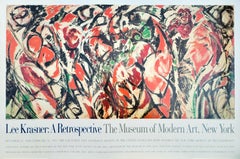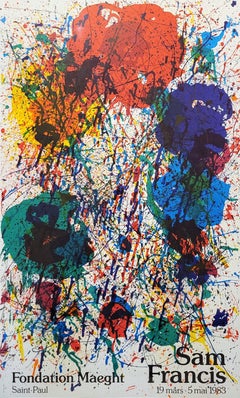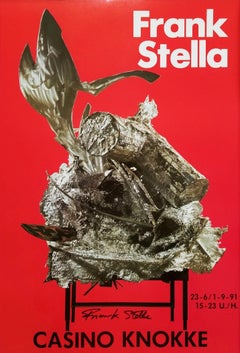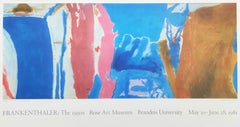Want more images or videos?
Request additional images or videos from the seller
1 of 12
(after) Mark RothkoLight Red Over Black1993
1993
$350List Price
About the Item
- Creator:(after) Mark Rothko (1903 - 1970, American)
- Creation Year:1993
- Dimensions:Height: 32.75 in (83.19 cm)Width: 22.75 in (57.79 cm)
- Medium:
- Movement & Style:
- Period:
- Condition:
- Gallery Location:Saint Augustine, FL
- Reference Number:1stDibs: LU12122383521
About the Seller
5.0
Platinum Seller
Premium sellers with a 4.7+ rating and 24-hour response times
Established in 1978
1stDibs seller since 2015
1,359 sales on 1stDibs
Authenticity Guarantee
In the unlikely event there’s an issue with an item’s authenticity, contact us within 1 year for a full refund. DetailsMoney-Back Guarantee
If your item is not as described, is damaged in transit, or does not arrive, contact us within 7 days for a full refund. Details24-Hour Cancellation
You have a 24-hour grace period in which to reconsider your purchase, with no questions asked.Vetted Professional Sellers
Our world-class sellers must adhere to strict standards for service and quality, maintaining the integrity of our listings.Price-Match Guarantee
If you find that a seller listed the same item for a lower price elsewhere, we’ll match it.Trusted Global Delivery
Our best-in-class carrier network provides specialized shipping options worldwide, including custom delivery.You May Also Like
Untitled (Two Figures)
By Willem de Kooning
Located in New York, NY
A very good impression of this scarce offset lithograph on cream wove paper. Artist's proof, aside from the edition of 100. Signed in ink, lower right, and inscribed "A/P" in pencil,...
Category
1970s Abstract Expressionist Abstract Prints
Materials
Lithograph, Offset
Adolph Gottlieb, rare exhibition print for Guild Hall in Easthampton, NY, Framed
By Adolph Gottlieb
Located in New York, NY
Adolph Gottlieb
Guild Hall is for Everyone, 1970
Rare Abstract Expressionist Offset Lithograph poster
Vintage metal Frame included
Rare vintage, limited edition, offset lithograph ...
Category
1970s Abstract Expressionist Abstract Prints
Materials
Lithograph, Offset
$800
H 34.5 in W 25.75 in D 0.5 in
Limited Edition Walker Art Center exhibition print, Hand Signed by Frank Stella
By Frank Stella
Located in New York, NY
Frank Stella
Frank Stella The Circuit Prints (Hand Signed), 1988
Color offset lithograph poster (hand signed by Frank Stella)
Signed and dated 88 in ink by Frank Stella directly unde...
Category
1980s Abstract Expressionist Abstract Prints
Materials
Lithograph, Offset
Royal Academy of Arts, London UK offset lithograph (Hand Signed by Frank Stella)
By Frank Stella
Located in New York, NY
Frank Stella
Frank Stella, Royal Academy of Arts (Hand Signed), 2000
Offset Lithograph poster on thin
Boldly hand signed and dated by Frank Stella in ink on the front
29 3/4 x 20 inches
Unframed
Accompanied by Certificate of Guarantee issued by Alpha 137 Gallery
This Frank Stella poster...
Category
Early 2000s Abstract Expressionist Abstract Prints
Materials
Lithograph, Offset
New York State Dare, Dream Discover, Offset lithograph Hand Signed Ed. of 100
By Frank Stella
Located in New York, NY
Frank Stella
The New York State Christopher Columbus Quincentenary Commission, 1991
Offset Lithograph Printed in Colors
Signed and dated by the artist in ink on the lower right front in black ink (Edition of 100)
Limited Edition of 100 (unnumbered)
39 1/2 × 23 1/2 inches
Unframed
Accompanied by gallery issued Certificate of Guarantee
This vibrant, hand signed offset lithograph poster designed by Frank Stella commemorates The New York State Christopher Columbus Quincentenary Commission. The poster alone is uncommon, but it is extremely rare to find a hand signed edition as this one. Highly collectible and desirable! An uncommon Stella print...
Category
1990s Abstract Expressionist Abstract Prints
Materials
Ink, Lithograph, Offset
$3,850
H 39.5 in W 23.5 in
London UK exhibition offset lithograph poster Hand signed by Frank Stella Framed
By Frank Stella
Located in New York, NY
Frank Stella
Frank Stella Prints 1980 - 2008 (Hand Signed), 2008
Offset Lithograph
Hand signed and dated on the front, in innk with inscription that read...
Category
Early 2000s Abstract Expressionist Abstract Prints
Materials
Lithograph, Offset
$2,800
H 25 in W 21 in D 0.5 in
John Chamberlain, Signed Western Union cable re: sculpture show at Leo Castelli
By John Chamberlain
Located in New York, NY
John Chamberlain
Hand Signed Letter re: Leo Castelli Exhibition, 1982
Typewriter on paper (hand signed)
6 1/2 × 8 1/2 inches
Hand-signed by artist, Signed in purple felt tip marker
Hand signed telegraph/letter refers to Chamberlain's exhibition at the legendary Leo Castell Gallery.
A piece of history!
John Chamberlain Biography
John Chamberlain (1927 – 2011) was a quintessentially American artist, channeling the innovative power of the postwar years into a relentlessly inventive practice spanning six decades. He first achieved renown for sculptures made in the late 1950s through 1960s from automobile parts—these were path-breaking works that effectively transformed the gestural energy of Abstract Expressionist painting into three dimensions. Ranging in scale from miniature to monumental, Chamberlain’s compositions of twisted, crushed, and forged metal also bridged the divide between Process Art and Minimalism, drawing tenets of both into a new kinship. These singular works established him as one of the first American artists to determine color as a natural component of abstract sculpture. From the late 1960s until the end of his life, Chamberlain harnessed the expressive potential of an astonishing array of materials, which varied from Plexiglas, resin, and paint, to foam, aluminum foil, and paper bags.
After spending three years in the United States Navy during World War II, Chamberlain enrolled in the Art Institute of Chicago and Black Mountain College, where he developed the critical underpinnings of his work. Chamberlain lived and worked in many parts of the United States, moving between New York City, Long Island, Los Angeles, Santa Fe, Connecticut, and Sarasota, before finally settling on Shelter Island. In many ways, each location provoked a distinct material sensibility, often defined by the availability of that material or the limitations of physical space. In New York City, Chamberlain pulled scrap metal and twelve-inch acoustic tiles from the ceiling of his studio apartment. He chose urethane in Los Angeles in 1965 (a material he had been considering for many years), and film in Mexico in 1968. He eventually returned to metal in 1972, and, in Sarasota, he expanded the scale of his works to make his iconic Gondolas (1981 – 1982). The movement of the artist and the subsequent evolution of the work is indicative not only of a kind of American restlessness but also of Chamberlain’s own personal evolution: he sometimes described his use of automobile materials as sculptural self-portraits, infused with balance and rhythm characteristic of the artist himself.
Chamberlain refused to separate color from his practice, saying, ‘I never thought of sculpture without color. Do you see anything around that has no color? Do you live in a world with no color?’. He both honored and assigned value to color in his practice—in his early sculptures color was not added, but composed from the preexisting palette of his chosen automobile parts. Chamberlain later began adding color to metal in 1974, dripping and spraying—and sometimes sandblasting—paint and lacquer onto his metal components prior to their integration. With his polyurethane foam works, color was a variable of light: ultraviolet rays or sunlight turned the material from white to amber. It was this profound visual effect that brought the artist’s personal Abstract Expressionist hand into industrial three-dimensional sculpture. Chamberlain moved seamlessly through scale and volume, creating material explorations in monumental, heavy-gauge painted aluminum foil in the 1970s, and later in the 1980s and 1990s, miniatures in colorful aluminum foil and chromium painted steel.
Central to Chamberlain’s works is the notion that sculpture denotes a great deal of weight and physicality, disrupting whatever space it occupies. In the Barges series (1971 – 1983) he made immense foam couches, inviting spectators to lounge upon the cushioned landscape. At the end of his career, Chamberlain shifted his practice outdoors, and through a series of determined experiments, finally created brilliant, candy-colored sculptures in twisted aluminum foil. In 2012, four of these sculptures were shown outside the Seagram Building in New York, accompanied by playful titles such as ‘PINEAPPLESURPRISE’ (2010) and ‘MERMAIDSMISCHIEF’ (2009). These final works exemplify Chamberlain’s lifelong dedication to change—of his materials, of his practice, and, consequently, of American Art.
Chamberlain has been the subject of numerous solo exhibitions, including two major Retrospectives at the Solomon R. Guggenheim Museum in New York NY in 2012 and 1971; ‘John Chamberlain, Squeezed and Tied. Foam and Paper Sculptures 1969-70,’ Dan Flavin Art Institute, Dia Center for the Arts, Bridgehampton NY (2007); ‘John Chamberlain. Foam Sculptures 1966–1981, Photographs 1989–2004,’ Chinati Foundation, Marfa TX (2005); ‘John Chamberlain. Current Work and Fond Memories, Sculptures and Photographs 1967–1995,’ Stedelijk Museum, Amsterdam, Netherlands (Traveling Exhibition) (1996); and ‘John Chamberlain. Sculpture, 1954–1985,’ Museum of Contemporary Art, Los Angeles CA (1986). Chamberlain’s sculptures are part of permanent exhibitions at the Chinati Foundation in Marfa TX and at Dia:Beacon in upstate New York. In 1964, Chamberlain represented the United States in the American Pavilion at the 32nd International Exhibition of the Venice Biennale. He received many awards during his life, including a Doctor of Fine Arts, honoris causa, from the College for Creative Studies, Detroit (2010); the Distinction in Sculpture Honor from the Sculpture Center, New York (1999); the Gold Medal from The National Arts Club Award, New York (1997); the Lifetime Achievement Award in Contemporary Sculpture by the International Sculpture Center, Washington D.C. (1993); and the Skowhegan Medal for Sculpture, New York NY (1993).
-Courtesy Hauser & Wirth
Leo Castelli
Leo Castelli was born in 1907 in Trieste, a city on the Adriatic sea, which, at the time, was the main port of the Austro-Hungarian Empire. Leo’s father, Ernest Kraus, was the regional director for Austria-Hungary’s largest bank, the Kreditandstalt; his mother, Bianca Castelli, was the daughter of a Triesten coffee merchant.
With the outbreak of World War I in 1914 the Kraus family relocated to Vienna where Leo continued his education. A particularly memorable moment for Leo during this period of his life was the funeral of Emperor Francis Joseph which he witnessed in November of 1916. Leo and his family returned to Trieste when the war ended in 1918. With the fall of the Austro-Hungarian Empire Trieste embraced its new Italian identity. Motivated by this shift Ernest decided to adopt his wife's more Italian-sounding maiden name, Castelli, which his children also assumed.
In many ways the Castelli’s return Trieste after the war marked an optimistic new beginning for the family. Ernest was made director of the Banca Commerciale Italiana, which had replaced the Kreditandstalt as the top bank in Trieste. This elevated position allowed Ernest and Bianca to cultivate a cosmopolitan life-style. Together they hosted frequent parties which brought them in contact with a spectrum of political, financial, and cultural luminaries. Growing up in such an environment fostered in Leo and his two siblings, Silvia and Giorgio, a strong appreciation of high culture. During this time Leo developed a passion for Modern literature and perfected his fluency in German, French, Italian, and English.
After earning his law degree at the University of Milan in 1932, Leo began his adult life as an insurance agent in Bucharest. Although Leo found the job unfulfilling and tedious, the people he met in Bucharest made up for this deficiency. Among the most significant of Leo’s acquaintances during this time was the eminent businessman, Mihail Shapira. Leo eventually became friendly with the rest of the Shapira family and in 1933 he married Mihail's youngest daughter, Ileana.
In 1934 Leo and Ileana moved to Paris where, thanks to his step-father’s influence, Leo was able to get a job in the Paris branch of the Banca d'Italia. In the same year, Leo met the interior designer René Drouin, who became his close friend. In the spring of 1938, while walking through the Place Vendôme, Leo and René came across a storefront for rent between the Ritz hotel and a Schiaparelli boutique. The space immediately impressed them as an ideal location for an art gallery, a plan which became reality the following spring in 1939. The Drouin Gallery opened with an exhibition featuring painting and furniture by Surrealist artists including Léonor Fini, Augene Berman, Meret Oppenheim, Max Ernst, and Salvador Dali. Despite the success of this initial exhibition, the gallery proved short-lived. Germany invaded Poland on September 1, 1939 marking the start of World War II and consequently the temporary end of the Drouin gallery. René was called to serve in the French army, while Leo, Ileana, and their three-year-old daughter Nina moved to the relative safety of Cannes, where Ileana’s family owned a summer house.
As the war escalated, it became evident that Europe was no longer safe for the Castelli family—Leo and Ileana were both Jewish. In March of 1941, Leo, Ileana and Nina fled to New York bringing with them Nina’s nurse Frances and their dog, Noodle. After a year of moving around the city, the family took up permanent residence at 4 East 77 Street in a townhouse Mihail had bought. Nine months after his arrival in New York, in December of 1943, Leo volunteered for the US army, expediting his naturalization as a US citizen. Owing to his facility with languages, Leo was assigned to serve in the U.S. Army Intelligence Corp, a position which he held for two years, until February 1946.
While on military leave in 1945 Leo visited Paris and stopped by Place Vendôme gallery where René had once more set up business selling work by European avant-garde artists such as Jean Dubuffet and Jean Fautrier. The meeting not only rekindled René and Leo’s friendship but also the latter’s interest in art dealing, a pursuit which Leo began to view as more than a mere hobby but as a potential career. After reconnecting, the two friends decided to go back into partnership with Leo acting as the New York representative for the Drouin Gallery. Working in this capacity, Leo began to form relationships with some of the New York art world’s most influential figures, including Peggy Guggenhiem, Sydney Janis, Willem De Kooning, and Jackson Pollock.
By the late 40s Leo’s ties with René Drouin had begun to slacken, while his alliance with the dealer Sydney Janis became closer. Janis opened his New York gallery in 1948 and in 1950 invited Leo to curate an exhibition of contemporary French and American artists. The show drew a significant connection between the venerable tradition of European Modernism and the emerging artists of the New York School. Not long after this, in 1951, Leo was asked by these same New York School artists to organize the groundbreaking Ninth Street Show. This exhibition was instrumental in establishing Abstract Expressionism as the preeminent art movement of the post-war era.
Leo founded his own gallery in 1957, transforming the living room on the fourth floor of the 77th Street townhouse into an exhibition space. Perhaps the most critical moment of Leo’s career occurred later that year, when he first visited the studios of Robert Rauschenberg and Jasper Johns. In 1958 Leo gave Johns and Rauschenberg solo shows, in January and March respectively. For Johns, this was the first solo show of his career. These exhibitions received wide critical acclaim, solidifying Leo’s reputation not only as a dealer but as the arbiter of a new and important art movement.
Over the course of the 1960s Leo played a formative role in launching the careers of many of the most significant artists of the twentieth century including Roy Lichtenstein, Andy Warhol, Claes Oldenberg, Cy Twombly, Donald Judd, Dan Flavin, Robert Morris, Bruce Nauman, Richard Serra, Joseph Kosuth and Lawrence Weiner. Through his support of these artists Leo likewise helped cultivate and define the movements of Pop, Minimalism, Conceptual Art, and Post-Minimalism.
As business expanded over the course of the 60s and artistic trends shifted in favor of larger artworks, Leo realized that his townhouse gallery was not sufficient to meet these new demands. Indicative of the trend toward maximal art...
Category
1980s Abstract Expressionist Abstract Prints
Materials
Ink, Lithograph, Offset
Experiment and Change, rare NSU Art Museum poster (Hand signed by Frank Stella)
By Frank Stella
Located in New York, NY
Frank Stella
Experiment and Change (Hand Signed), 2017
Offset Lithograph
Hand signed by the artist i ink on the lower right front
22 × 27 4/5 inches
Unframed
This offset lithograph ...
Category
2010s Abstract Expressionist Abstract Prints
Materials
Lithograph, Offset
Print of Abstract Expressionist sculptor John Chamberlain, Hand Signed by artist
By John Chamberlain
Located in New York, NY
John Chamberlain (Hand Signed), 1988
Offset Lithograph Poster (Hand Signed by John Chamberlain)
30 × 20 inches
Boldly signed on the recto in white grease marker by the artist in his ...
Category
1980s Abstract Expressionist Portrait Prints
Materials
Permanent Marker, Lithograph, Offset
Frank Stella Hand Signed 93/100 Whitney Museum Lithograph Abstract Expressionist
By Frank Stella
Located in New York, NY
Frank Stella
Large Limited Edition Hand Signed Whitney Museum Print, 1985
Offset Lithograph
Hand signed, dated and numbered 93 from the edition of 100, lower left front
75 7/10 × 52 ...
Category
1980s Abstract Expressionist Abstract Prints
Materials
Lithograph, Offset
$3,500
H 75.7 in W 52.75 in
More From This Seller
View AllLee Krasner: A Retrospective - The Museum of Modern Art (Celebration) Poster
By Lee Krasner
Located in Saint Augustine, FL
Artist: (after) Lee Krasner (American, 1908-1984)
Title: "Lee Krasner: A Retrospective - The Museum of Modern Art (Celebration)"
*Signed and dated in the plate (printed signature) lo...
Category
1980s Abstract Expressionist Abstract Prints
Materials
Lithograph, Offset
Untitled (SF-229P) (Fondation Maeght) Poster /// Sam Francis Abstract Expression
By Sam Francis
Located in Saint Augustine, FL
Artist: Sam Francis (American, 1923-1994)
Title: "Untitled (SF-229P) (Fondation Maeght)"
Year: 1983
Medium: Original Offset-Lithograph, Exhibition Poster on light wove paper
Limited ...
Category
1980s Abstract Expressionist Abstract Prints
Materials
Lithograph, Offset
Casino Knokke Poster (Signed) /// Contemporary Abstract Sculpture Frank Stella
By Frank Stella
Located in Saint Augustine, FL
Artist: (after) Frank Stella (American, 1936-)
Title: "Casino Knokke"
Series: Casino Knokke Posters
*Signed by Stella in black marker lower center
Year: 1991
Medium: Original Offset-Lithograph, Exhibition Poster on glossy wove paper
Limited edition: Unknown
Printer: Unknown
Publisher: Casino Knokke, Knokke, Belgium
Sheet size: 24.5" x 16.63"
Condition: Some minor handling creases. In excellent condition
Very rare
Notes:
Provenance: private collection - Paris, France; acquired directly from the exhibition at Casino Knokke, Knokke, Belgium. Poster produced for a special exhibition of Stella's work at Casino Knokke, Knokke, Belgium from June 23 - September 1, 1991. The artwork featured on this poster is Stella's 1991, 133" x 87" x 75" stainless steel, bronze, copper, aluminum and carbon steel sculpture "Raft of the Medusa, Part IV". Comes with its rare 56 page softcover exhibition catalogue "Frank Stella: Casino Knokke" featuring 18 artworks.
GIA Gallery Poster Disclaimer:
Not to be confused with thousands of contemporary inkjet/giclée/digital reproductions ignorantly or deliberately passed off as originals on the market today. The examples we offer here are the original period vintage (exhibition) posters, created and designed by, or under the supervision and authorization of the artist or their respective estate (posthumously), for various exhibitions and events in which they participated. If applicable, this poster is also fully documented within its respective artists' official catalogue raisonné of authentic graphic works, prints, and or posters.
Biography:
Frank Stella (1936-) is an American artist best known for his use of geometric patterns and shapes in creating both paintings and sculptures. Arguably one of the most influential living American artists, Stella’s works utilize the formal properties of shape, color, and composition to explore non-literary narratives, as seen in his work Harrar II (1967) from the Protractor series. “Abstraction didn't have to be limited to a kind of rectilinear geometry or even a simple curve geometry. It could have a geometry that had a narrative impact. In other words, you could tell a story with the shapes,” he explained. “It wouldn't be a literal story, but the shapes and the interaction of the shapes and colors would give you a narrative sense. You could have a sense of an abstract piece flowing along and being part of an action or activity.” Born on May 12, 1936 in Malden, MA, Stella went on to study history at Princeton University before moving to New York in 1958. Having moved to the city, Stella was immersed in the heyday Abstract Expressionism, but it was the work of Jasper Johns that inspired Stella’s Black...
Category
1990s Abstract Expressionist Abstract Prints
Materials
Lithograph, Offset, Permanent Marker
$1,200 Sale Price
52% Off
Rose Art Museum (Open Wall) Poster /// Helen Frankenthaler Female Abstract Art
By Helen Frankenthaler
Located in Saint Augustine, FL
Artist: (after) Helen Frankenthaler (American, 1928-2011)
Title: "Rose Art Museum (Open Wall)"
Year: 1981
Medium: Original Offset-Lithograph, Exhibition Poster on light wove paper
Li...
Category
1980s Abstract Expressionist Abstract Prints
Materials
Lithograph, Offset
Untitled (One Cent Life) /// Joan Mitchell Female Artist Abstract Expressionism
By Joan Mitchell
Located in Saint Augustine, FL
Artist: Joan Mitchell (American, 1925-1992)
Title: "Untitled" (Page 92-93)
Portfolio: One Cent Life
*Unsigned edition
Year: 1964
Medium: Original Lithograph on wove paper
Limited edi...
Category
1960s Abstract Expressionist Abstract Prints
Materials
Lithograph
Greenwich Arts Council Poster /// Abstract Expressionist Robert Motherwell NY
By Robert Motherwell
Located in Saint Augustine, FL
Artist: Robert Motherwell (American, 1915-1992)
Title: "Greenwich Arts Council"
*Issued unsigned, though signed by Motherwell in the plate (printed signature) center right
Year: 1976
Medium: Original Lithograph, Exhibition Poster on Strathmore paper
Limited edition: 700. (There was also a signed and numbered edition of 42)
Printer: Tyler Graphics, Ltd., Mount Kisco, NY
Publisher: Greenwich Arts Council, Greenwich, CT
Reference: "The Prints of Robert Motherwell - A Catalogue Raisonné 1943-1984" - Belknap Appendix: No. 28, page 282; "Robert Motherwell - The Complete Prints 1940-1991" - Engberg No. 202
Sheet size: 37.25" x 23"
Condition: Never framed, has been professionally stored away for decades. Some minor edge wear. In excellent condition
Rare
Notes:
Printed in three colors: black, green, and cream. Poster produced for a special exhibition "Sculpture 76" at The Greenwich Arts Council, Greenwich, CT from June - October, 1976. The image featured on this poster is Motherwell's 1972 acrylic painting on paper "Greenwich Sculpture". Artist's copyright lower left and printer's imprint lower right.
GIA Gallery Poster Disclaimer:
Not to be confused with thousands of contemporary inkjet/giclée/digital reproductions ignorantly or deliberately passed off as originals on the market today. The examples we offer here are the original period vintage (exhibition) posters, created and designed by, or under the supervision and authorization of the artist or their respective estate (posthumously), for various exhibitions and events in which they participated. If applicable, this poster is also fully documented within its respective artists' official catalogue raisonné of authentic graphic works, prints, and or posters.
Biography:
Robert Motherwell was born January 24, 1915, in Aberdeen, Washington. He was awarded a fellowship to the Otis Art Institute in Los Angeles at age 11, and in 1932 studied painting briefly at the California School of Fine Arts in San Francisco. Motherwell received a B.A. from Stanford University in 1937 and enrolled for graduate work later that year in the Department of Philosophy at Harvard University, Cambridge, Massachusetts. He traveled to Europe in 1938 for a year of study abroad. His first solo show was presented at the Raymond Duncan...
Category
1970s Abstract Expressionist Abstract Prints
Materials
Lithograph
Recently Viewed
View AllMore Ways To Browse
Large Rectangular Paintings
P Salinas Print
Large Rectangular Paintings
Large Rectangular Paintings
Large Rectangular Paintings
Large Rectangular Paintings
Large Rectangular Paintings
Large Rectangular Paintings
Large Rectangular Paintings
Large Rectangular Paintings
Large Rectangular Paintings
Large Rectangular Paintings
Large Rectangular Paintings
Large Rectangular Paintings
Large Rectangular Paintings
Sidney Beck
Sinuhe Villegas
Slowinski Painting



